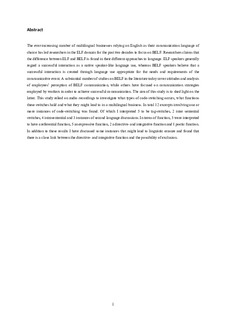Forms and Functions of Code-Switching in Business English as a Lingua Franca
Master thesis
Permanent lenke
http://hdl.handle.net/11250/2568647Utgivelsesdato
2018Metadata
Vis full innførselSamlinger
Sammendrag
The ever-increasing number of multilingual businesses relying on English as their communication language of choice has led researchers in the ELF domain for the past two decades to focus on BELF. Researchers claims that the difference between ELF and BELF is found in their different approaches to language. ELF speakers generally regard a successful interaction as a native speaker-like language use, whereas BELF speakers believe that a successful interaction is created through language use appropriate for the needs and requirements of the communicative event. A substantial number of studies on BELF in the literature today cover attitudes and analysis of employees’ perception of BELF communication, while others have focused on communication strategies employed by workers in order to achieve successful communication. The aim of this study is to shed light on the latter. This study relied on audio recordings to investigate what types of code-switching occurs, what functions these switches hold and what they might lead to in a multilingual business. In total 12 excerpts involving one or more instances of code-switching was found. Of which I interpreted 5 to be tag-switches, 2 inter sentential switches, 4 intrasentential and 3 instances of second language discussions. In terms of function, 5 were interpreted to have a referential function, 5 an expressive function, 2 a directive- and integrative function and 1 poetic function. In addition to these results I have discussed some instances that might lead to linguistic erasure and found that there is a close link between the directive- and integrative function and the possibility of exclusion.
